Best Things to Do in Skopje: Your Comprehensive Travel Guide to Europe’s Most Kitsch Capital
Skopje, the capital of North Macedonia, is one of Europe’s least-visited and best value capital cities. It’s city of contrasts – one of the oldest settlements in Europe but one which continues to reinvent itself. Aptly referred to as the City of Statues, but don’t be surprised if you find Macedonian food and hospitality lingers longest in your memory.
If you’re ready to explore one of Europe’s most intriguing capitals, then this guide is for you. It covers everything from must-see sights and day trips to transport tips and practical details.
Planning a Trip To Skopje? Here’s Where You’ll Find Things
Here’s some more travel inspiration for North Macedonia from One Small Bag
This guide may include a few affiliate links. If you choose to buy something through one of them, I may earn a small commission (at no cost to you). Thank you for supporting One Small Bag and helping keep this resource ad-free and independent.
Skopje City Guide
Perfect for … A budget-friendly European City Break 🕌 Ottoman history and bazaars • 🗿 Quirky cityscapes • 💶 Side Trips in N Macedonia & Kosovo • 🍽️Delicious Macedonian Food & Wine
For centuries Skopje thrived as a trading crossroads. Its bazaars and caravanserais served merchants on the Balkan routes and those travelling onwards to the Silk Road. By the 1950s it was firmly on the Yugoslav tourist circuit, alongside Ohrid, the Adriatic coast and Belgrade. That all changed abruptly in 1963, when a devastating earthquake flattened much of the city. The rebuild brought stark, brutalist concrete, then that received a 21st Century makeover, more recently, with project Skopje 2014. These fake neo-classical facades and new monuments are an effort to recreate a traditional European capital. One thing is for sure, there’s a feast for the eyes around every corner.
I’d suggest spending at least two days in the city and then extend into a wider Balkan holiday by adding some side trips. We loved exploring the area, and I hope this guide helps you plan your own visit too.
Places to Stay in Skopje
Accommodation is excellent value in Skopje. For the full on Skopje experience, stay at mid-range Hotel Senigallia – the full-sized galleon moored on the Vardar with unbeatable central views. We stayed in “Flatiron” Apartments, a budget-friendly apartment, close to the train and bus station – a ‘mock-up’ of the New York Flatiron building, but considerably cheaper to stay there!
You’ll find a range of apartments and hotels for different budgets on this accommodation map.
Things to Do in Skopje
The best way to make sense of Skopje is simply to walk it. Start with the area around the old bazaar and get a feel for Skopje’s history. From there it’s only a few steps to the marble facades, statues and fountains and over the river to the rest of the modern city.
Skopje Map of Things to Do
The Old Bazaar & Ottoman Skopje
We’ll start our journey by heading towards the bazaar where we enter another era. Here mosques, hammams and caravanserais cluster around cobbled lanes and market stalls.
Skopje Old Bazaar
The Old Bazaar has been the heart of Skopje since Ottoman times. Once, one of the most important trading posts on the Balkan peninsula and today it’s a lively tangle of lanes where history and everyday life mingle.
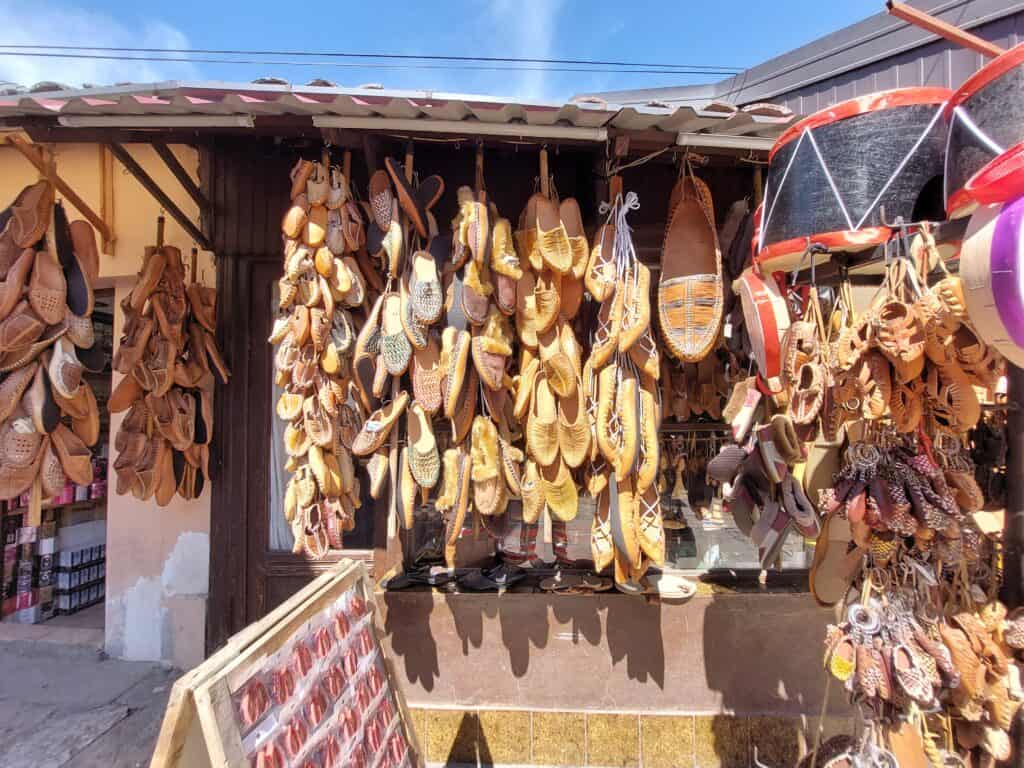
Among the cobbles you’ll find everything from leather shoes and traditional stalls to shops stacked with sweets and cakes, umbrella-shaded streets and artists selling their paintings. Take your time here to browse, people-watch and soak up the atmosphere. There are plenty of food and drink and options, to keep you here too.



The area around the bazaar, remains busy well into the evening and it’s a wonderful place to come for drinks or something to eat after dark. I’d recommend Old Town Brewery.
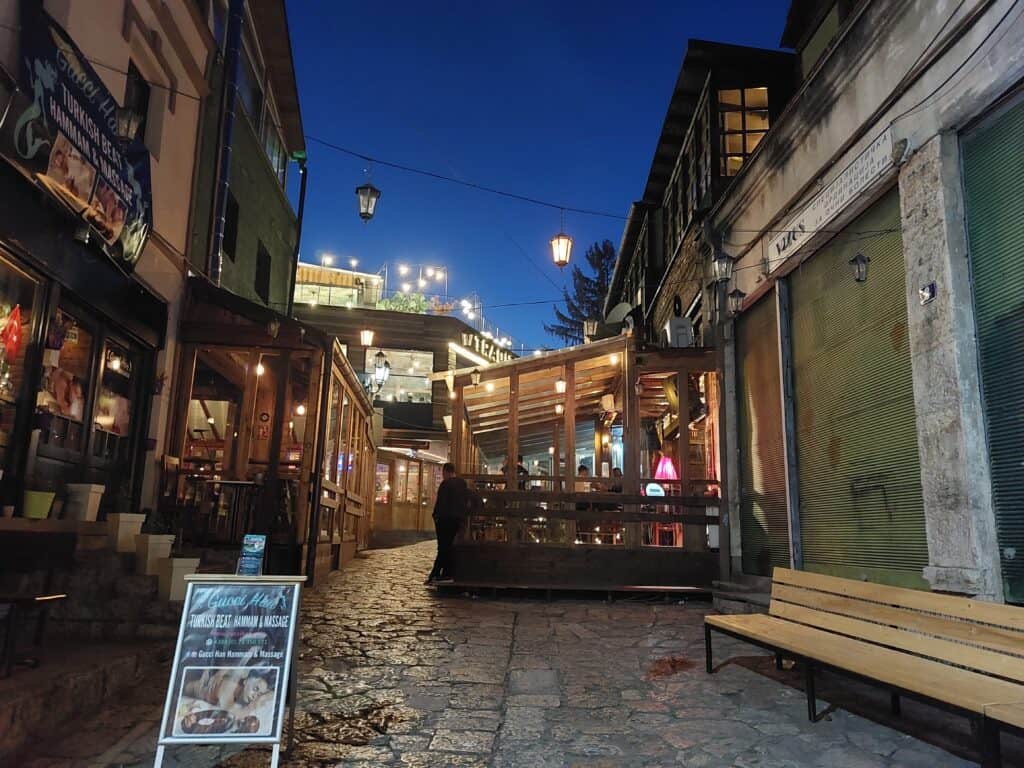
Skopje’s Ottoman Inns and Hammams
Beyond the shops and cafés, you’ll find some of Skopje’s most striking Ottoman landmarks, including mosques, hammams and caravanserais that have been here for centuries.
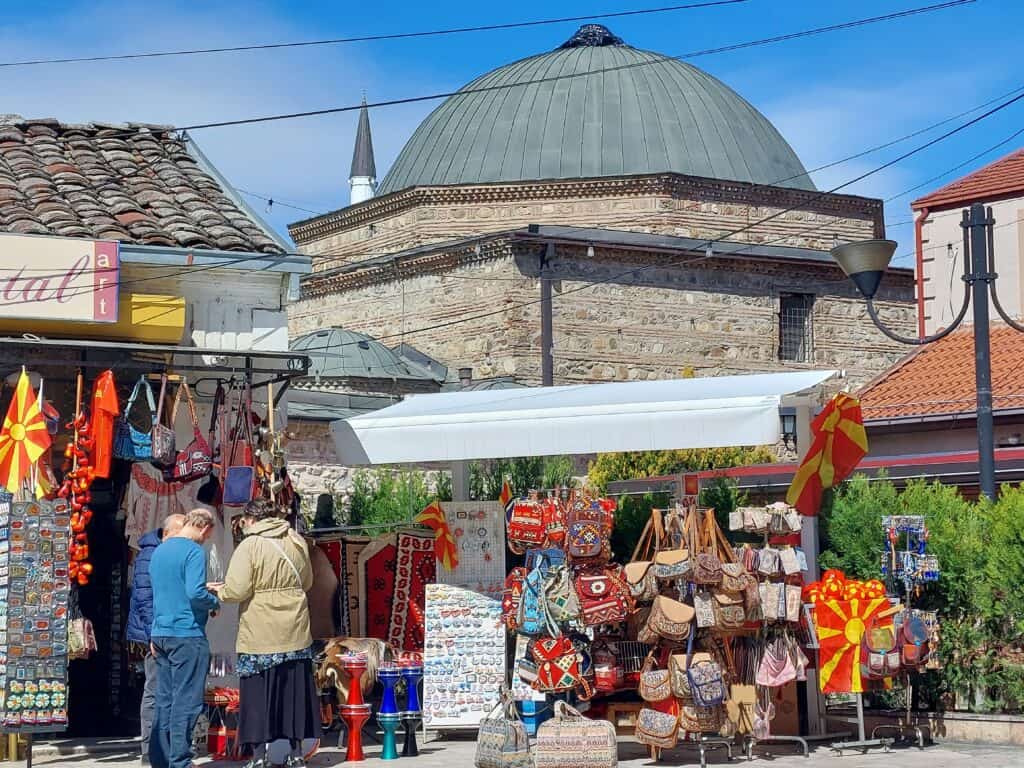
The dome here belongs to the Čifte Hammam, a 15th-century bathhouse, now housing part of the National Gallery of North Macedonia. A short stroll away is the Kuršumli An, once a caravanserai where merchants and their pack animals sheltered overnight. Take a peek inside, its thick walls and domes are still standing. Both sites now form part of the Museum of Macedonia complex.
Mustafa Pasha Mosque
Perched just above Skopje’s Old Bazaar, the Mustafa Pasha Mosque is one of those places that makes you pause for a moment. Built in 1492, it’s a calm retreat from the city below. Step inside for the restrained floral patterns and Arabic calligraphy giving it a quiet understated elegance. It’s a complete contrast to the flamboyant, kaleidoscope of colours in the Painted Mosque in Tetovo, which I would also highly recommend for your trip to North Macedonia.
Mustafa Pasha’s tomb still lies in the courtyard. If you’re wandering the bazaar, it’s worth climbing the short hill for both the view back over Skopje and a glimpse into the city’s Ottoman past.
Bit Pazar (Green Market)
If you keep walking north, the Green Market (Bit Pazar) offers a more modern slice of local life, with fruit, vegetables and everyday goods piled high in a maze of stalls.
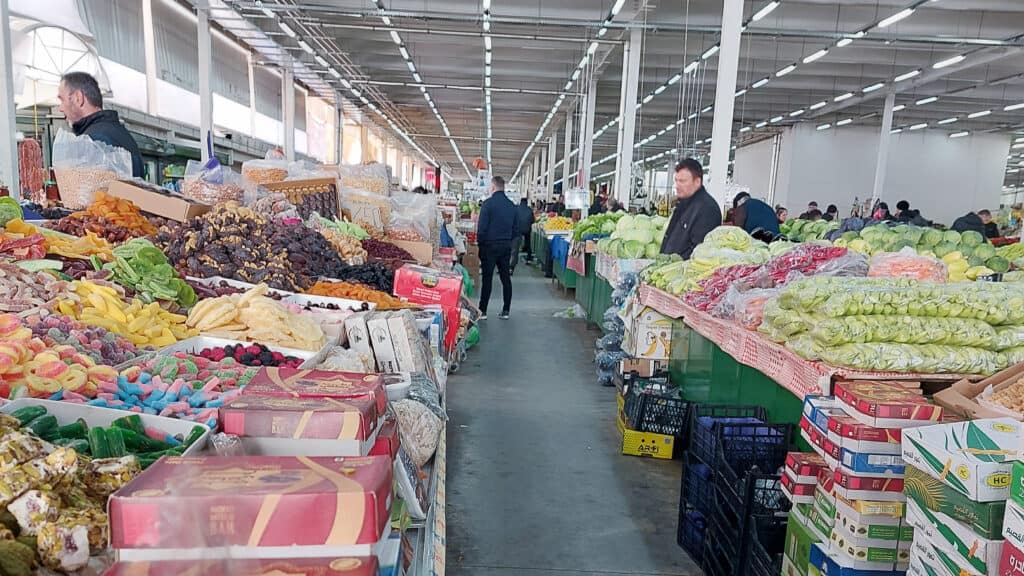
Skopje Fortress (Kale Fortress)
Perched on the hill above the Old Bazaar, the Skopje Fortress (or Kale) has guarded the city since Byzantine times, later reinforced under Ottoman rule. The thick stone walls and towers you see today have been rebuilt many times after earthquakes and invasions, but they still dominate the skyline.

It’s a short walk up from the bazaar, and if you climb onto the ramparts you’ll be rewarded with wide views across the river and city. On a clear day you can spot everything from the new town blocks to Mount Vodno in the distance. Parts of the complex also house the Museum of the Republic of North Macedonia, though the real highlight is simply wandering the walls and imagining the centuries of history they’ve witnessed.
Skopje Stone Bridge
The stone bridge, connects the modern and Ottoman parts of the city and spans the river Vardar, the largest in Macedonia. It’s built on Roman foundations and has been reconstructed several times, but it’s still kept the original architectural style. It’s not dissimilar to Prague’s Charles Bridge, although there are many less famous comparisons dotted around Europe too, including Ponte Di Tiberio from Rimini, which I visited recently. You will almost certainly walk over this bridge as you wander the city centre.

From the bazaar it’s only a few steps to the Vardar, where Skopje’s boldest modern makeover lines the riverbanks.
Skopje 2014 and Modern Skopje
Before we go further, let’s provide some context – here’s a little bit about the controversial Project – Skopje 2014.
Skopje 2014: A City Rebuilt in Marble and Bronze
After the 1963 earthquake, Skopje was largely rebuilt in stark concrete blocks and brutalist designs. In 2010, the government launched the “Skopje 2014” project to give the city a more “European” look. Dozens of neoclassical-style facades, monumental statues and fountains appeared almost overnight, especially along the riverfront.
The results are divisive. Supporters see it as an attempt to give Skopje grandeur and tourist appeal. Many locals, though, regard it as kitsch at best – and at worst an indulgent waste of public money, covering up the city’s modernist heritage with fake marble and oversized warriors. Whether you find it inspired or in bad taste, it’s impossible to miss, and it’s now part of what makes Skopje so distinctive.
Now, time to cross the Stone Bridge and arrive in Macedonia Square, the heart of the modern city.
Macedonia Square and Warrior Statue
You can’t miss the main Macedonia Square, with a massive statue of a warrior on top of a large fountain. Surrounding the square is a large shopping centre, plus bars and restaurants. The square is used for events and as a meeting place for residents and visitors alike. It’s a great place to linger and soak up the atmosphere. If you want to stop for a drink or bite to eat, I recommend Kolektiv in the square for super-friendly service.

This picture shows the approach from Stone Bridge, with Mount Vodno and the Millennium Cross in the background. A trip up the mountain in the cable car, is an essential part of your trip to Skopje.
Skopje Woman Warrior Park and Statues
Right next to Macedonia square, you’ll find Woman Warrior Park, although I failed to find any women warriors here! Maybe you could count the winged lady on top with Prometheus stuck in front? You’ll typically find statues of Prometheus naked, but the residents of Skopje insisted this one kept his modesty and his pants on! Good call!

Once you’ve had your fill of statues in this park, it’s time to return to the river front area, where there are plenty more!

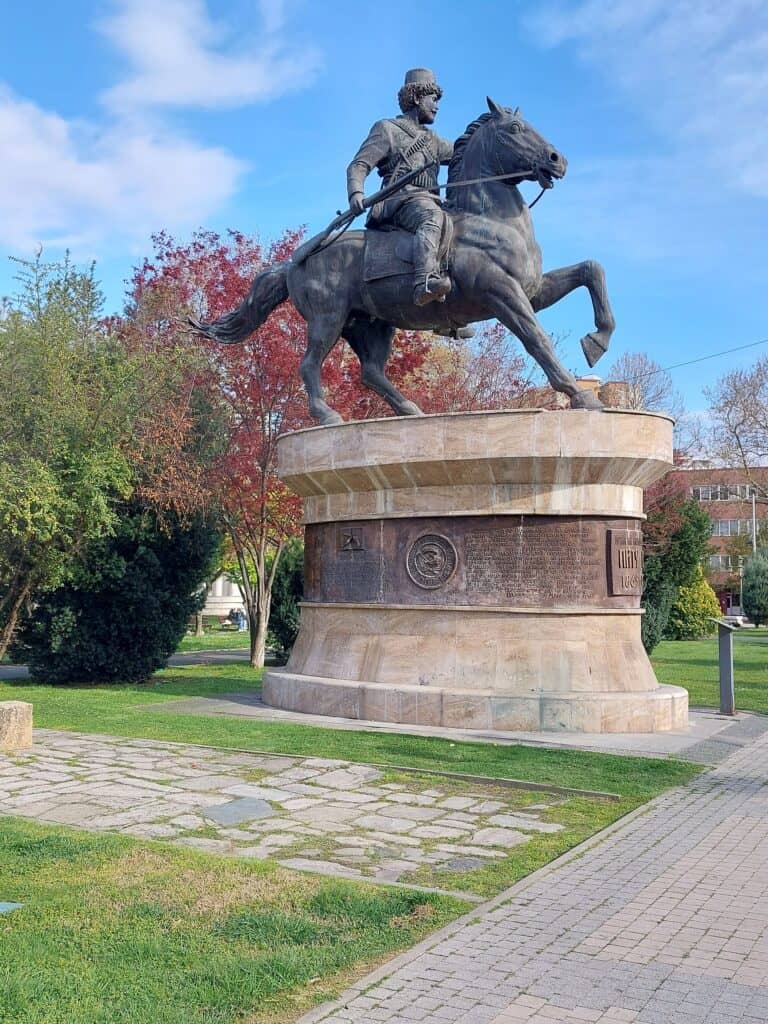
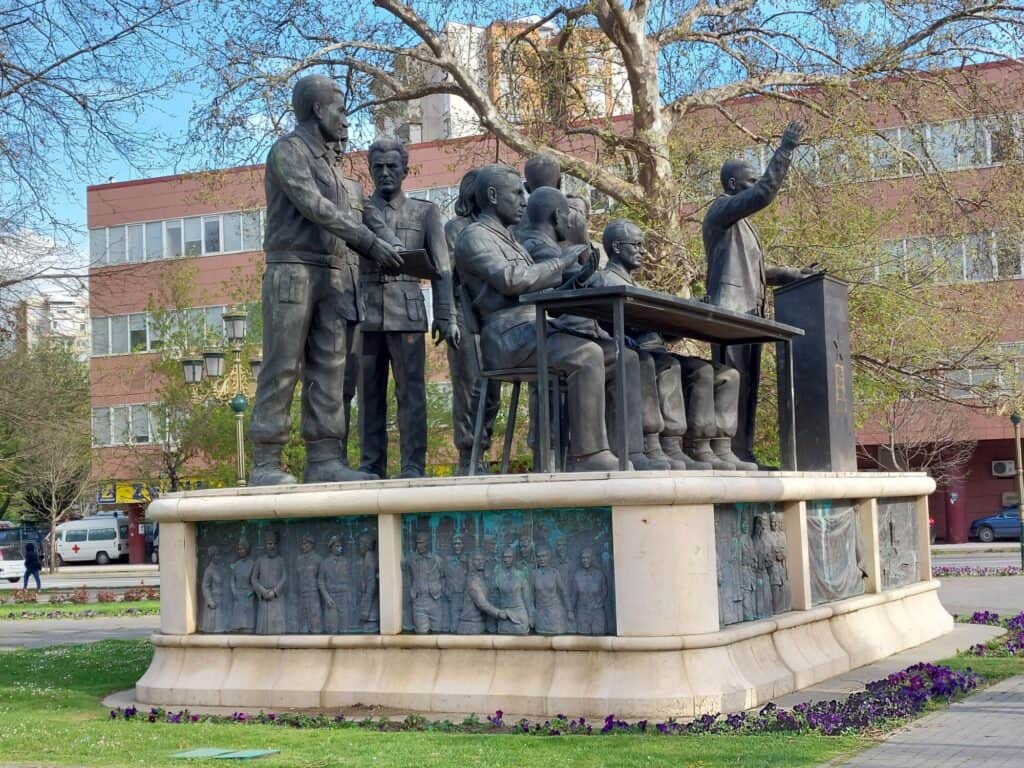
Riverside Galleons, Stalls and Cafes
Perhaps the most surreal sight along the riverfront are the two full-sized galleons moored permanently on the Vardar. One has been left to rot, windows broken and decks sagging – a ghost ship. The other has been spruced up and now operates as a hotel and restaurant, its polished wood and tidy deck looking oddly out of place against the neoclassical facades and fountains. Love them or loathe them, the galleons are impossible to miss and probably one of the most photographed part of Skopje’s “new look.”

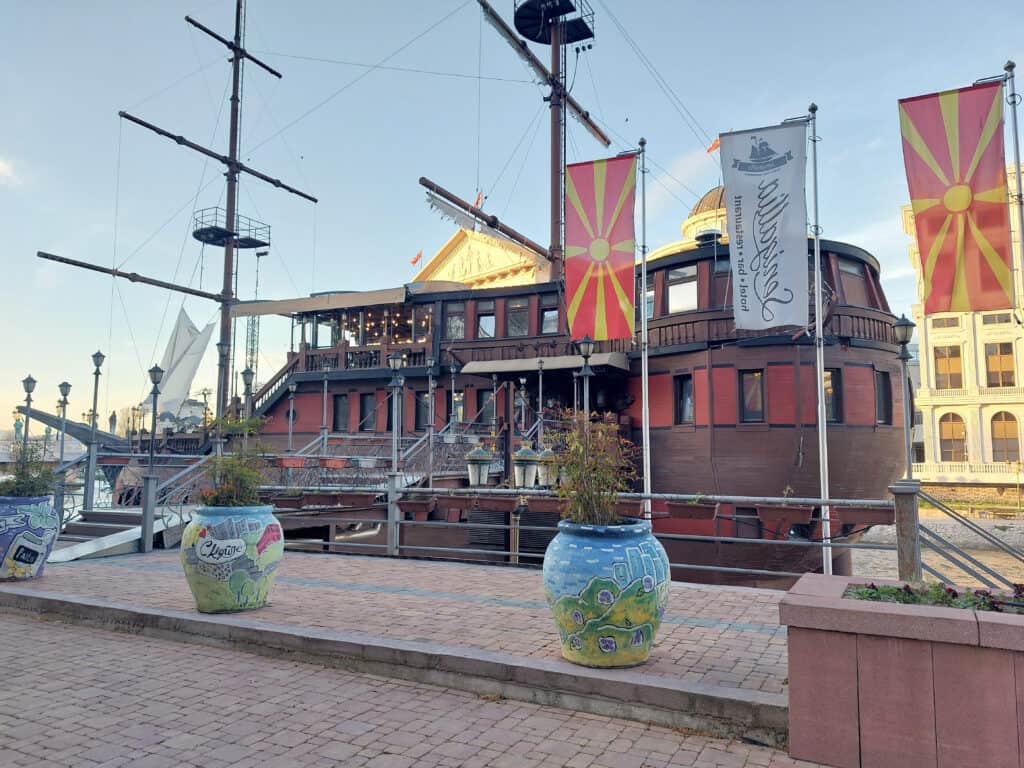
If you walk further along the riverfront, you’ll find colourful stalls selling coffee, snacks, books and souvenirs and plenty of cafes too.

Bridge of Civilisation
Once you’ve wandered along the west side of the river bank, head to the Bridge of Civilisation, also called the Art bridge. You won’t miss it! It’s a most remarkable bridge lined by statues on both sides.
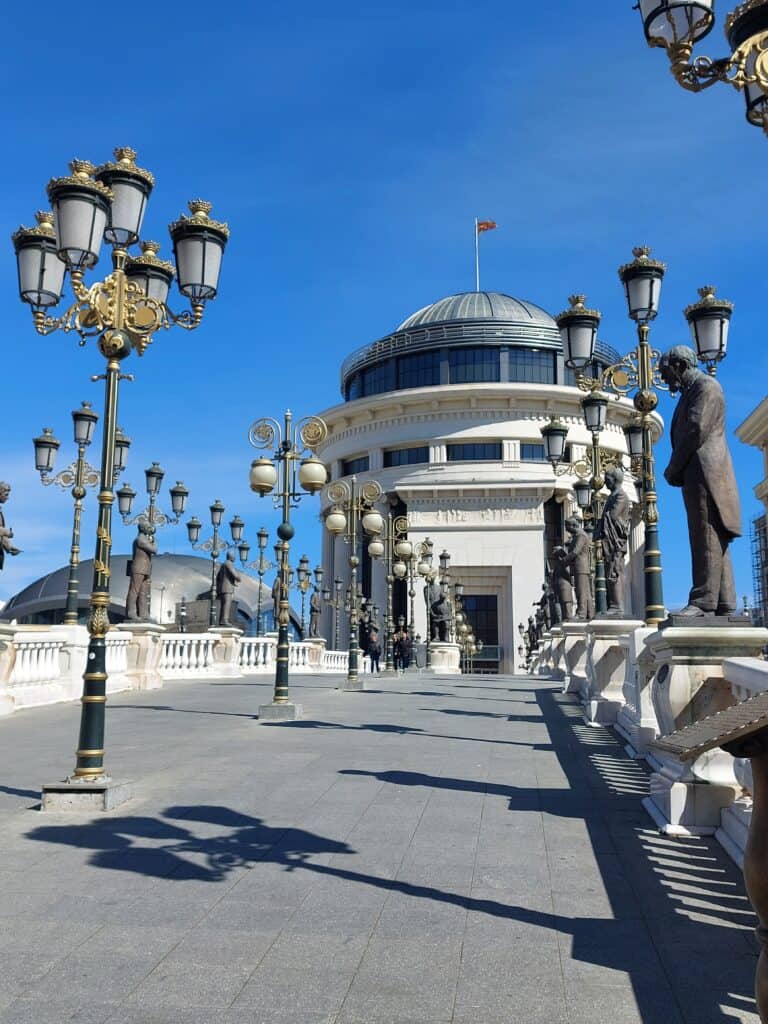

Walk over this bridge to find museums, other neo-classical buildings, fountains and statues, many part of Skopje 2014. But the grandest building of them all, Skopje’s Archaeological Museum of the Republic of Macedonia, is in front of you as you as you cross the bridge.
Here’s some more travel inspiration for North Macedonia from One Small Bag
Archaeological Museum of the Republic of Macedonia & More
The Archaeological Museum of the Republic of Macedonia museum is grand on the outside and packed full of artefacts from Macedonian history inside.

Just behind the archaeological museum, you’ll find more museums. The Museum of the Macedonian Struggle in a more baroque style and also the Macedonian Holocaust Museum,
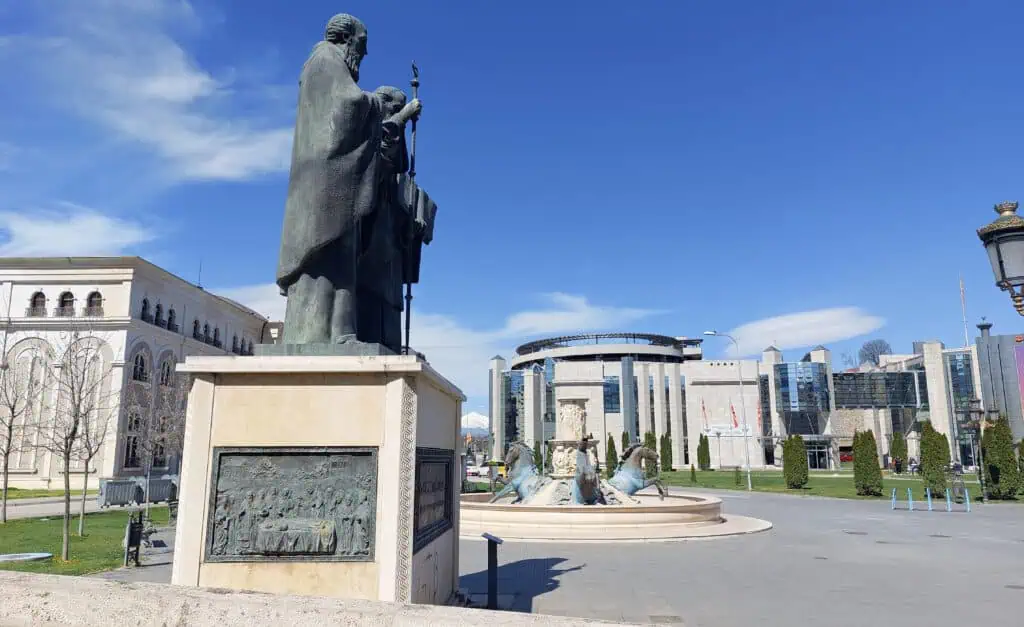
Here are the museum entry hours and prices.
| Museum | Days & Hours | Prices |
|---|
| Archaeological Museum of North Macedonia | Tuesday to Sunday, 10:00-18:00. | MKD 150 (~€2.50 / ~£2.10) |
| Museum of the Macedonian Struggle | Tuesday to Sunday, 10:00-18:00. | MKD 300 (~€5.00 / ~£4.15) |
| Holocaust Memorial Center for the Jews of Macedonia | Tuesday to Friday, 09:00-19:00; Saturday and Sunday, 09:00-15:00. | MKD 100 (~€1.70 / ~£1.40) |
I love how the different styles, animals and people are all combined together. There’s so much going on and honestly, there’s far more than I can capture here. You’ll just need to go and look for yourself. The City of Statues is exactly as described!
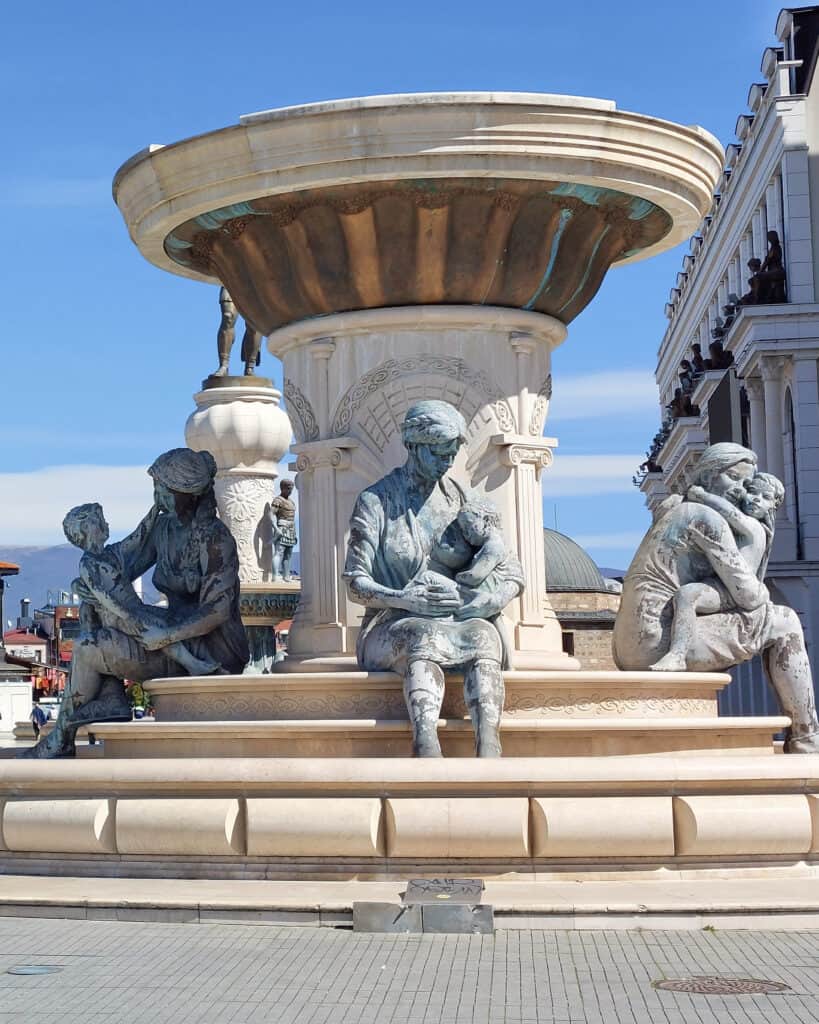
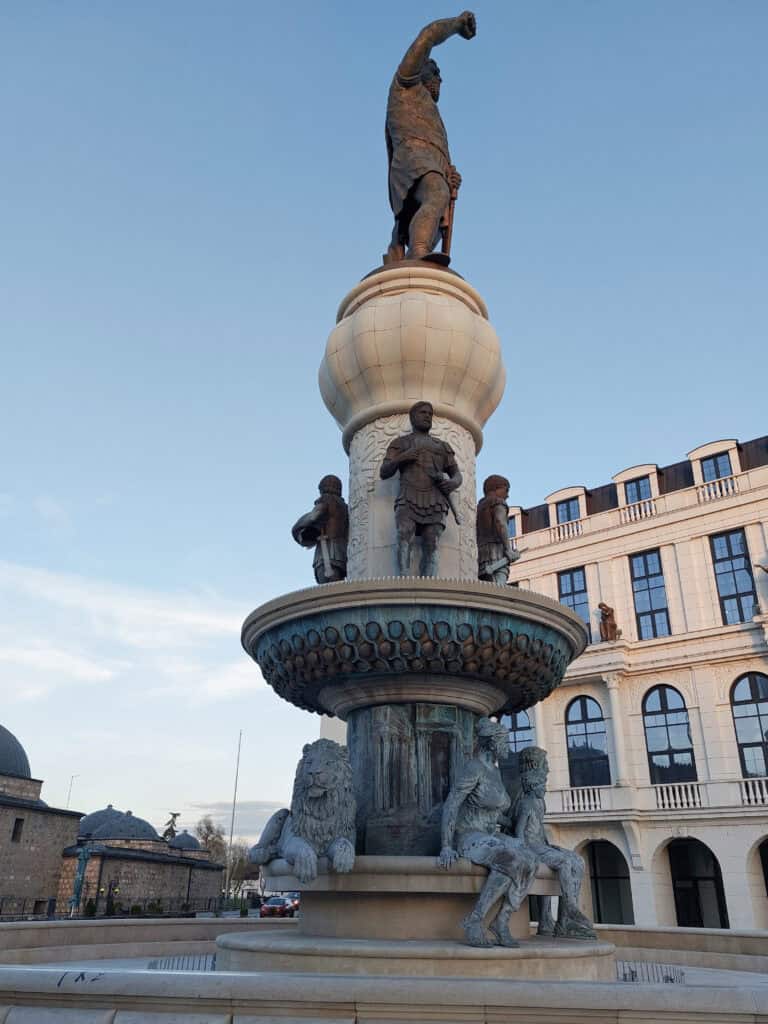
Music Venues including Philharmonic Hall
Not in the same neoclassical style, but you’ll also find the city’s classical music venues in the area.


We like to see what music is on whenever we visit somewhere. An opportunity to see a national orchestra playing in the capital’s main concert hall was definitely worth doing. The hall is impressive both inside and out as was the performance. We were relieved it wasn’t a ‘dress up’ event, as we weren’t dressed up!
Cathedral of St Clement of Ohrid
Nearly half the population of North Macedonia are Eastern Orthodox, and Skopje’s main Orthodox cathedral is one of the city’s most striking landmarks. Dedicated to St Clement of Ohrid, it took almost 20 years to complete before being consecrated in 1990, on the 115th anniversary of the saint’s death.
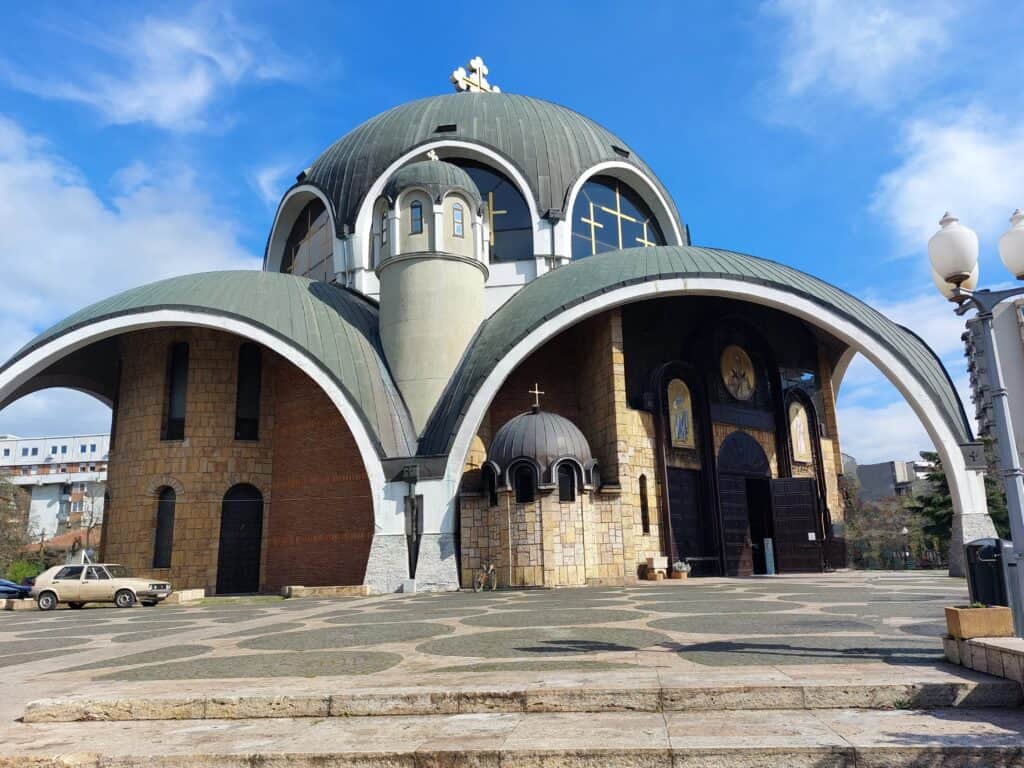
The cathedral itself is a bold modernist design – a vast central dome flanked by four smaller domes at the corners – but step inside and the contrast is striking. The interior is richly traditional, with an elaborate iconostasis, vivid frescoes and a sense of scale that’s genuinely breath-taking. Outside, the soaring white clock tower adds a distinctive vertical counterpoint to the domes, a modern reimagining of the old Balkan saat kula towers that once marked time across the region. Together, the cathedral and tower are both a place of worship and a powerful symbol of the city’s Orthodox faith.

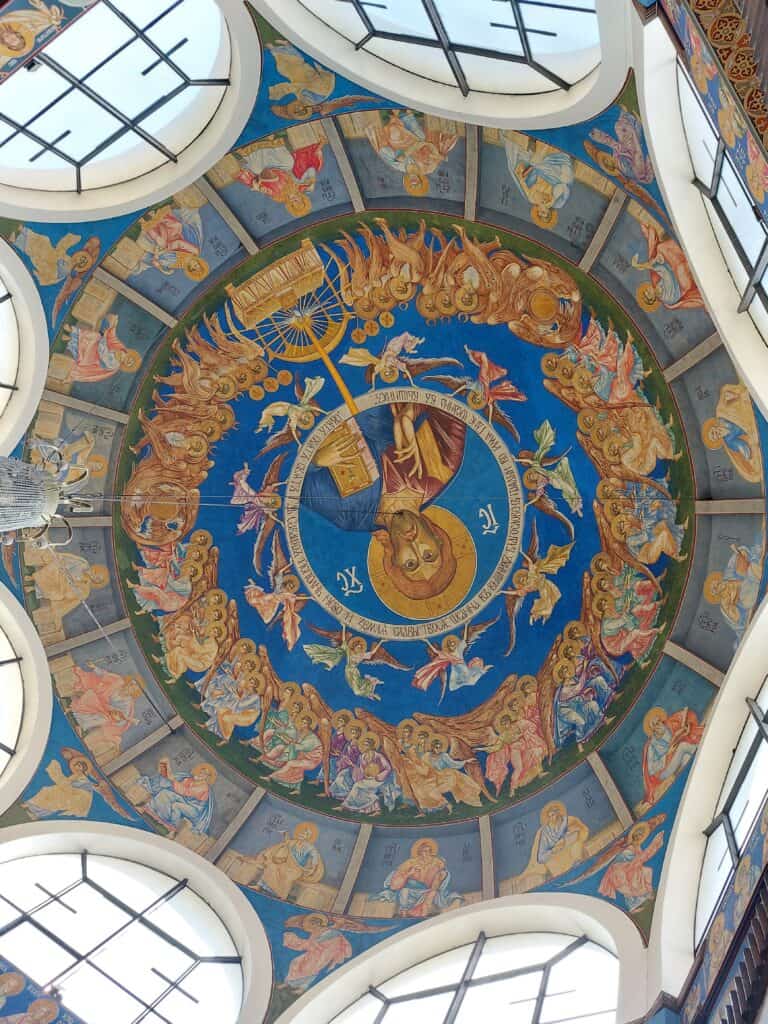
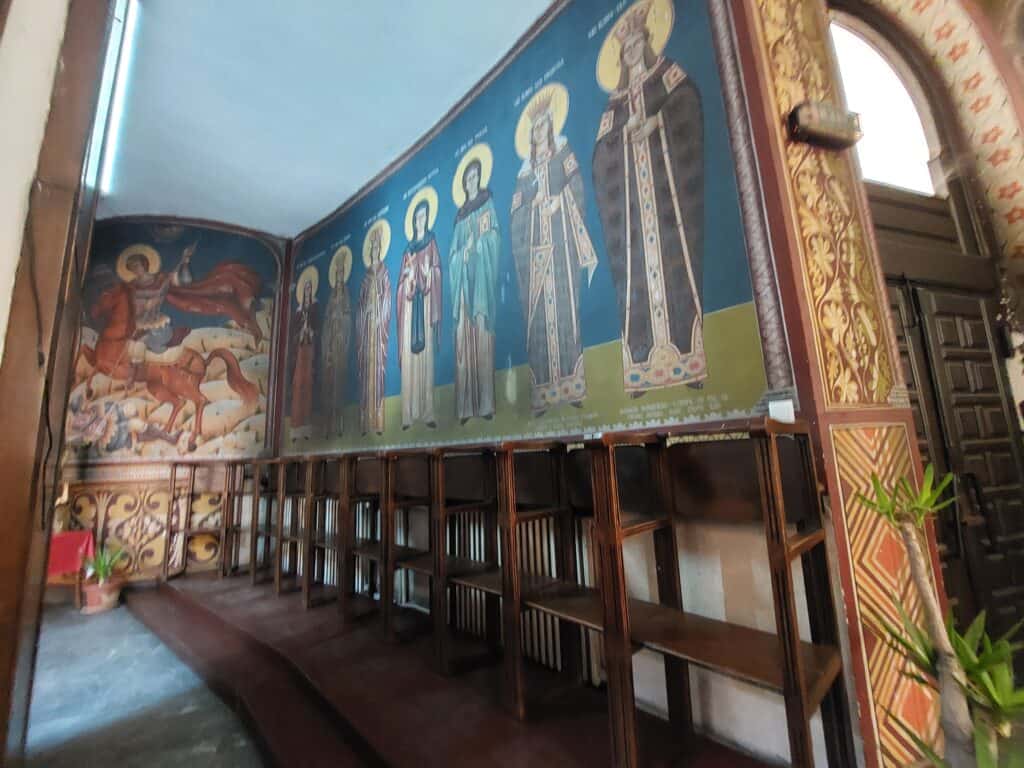
Memorial House of Mother Teresa
Skopje is the birthplace of Mother Teresa. On the site of the church where she was baptised now stands a memorial house dedicated to her life and work. Opened in 2009, it’s part museum, part shrine – with photographs, personal items and gifts from world leaders, alongside a reconstruction of her childhood home. A statue of Mother Teresa greets you at the entrance, and upstairs the striking glass-walled chapel feels both modern and contemplative.

I found it a moving place to visit, perhaps because Mother Teresa was such a well-known figure during my own lifetime, but also because her story still resonates as one of genuine faith and selfless service. Whether you share that background or not, it’s well worth stepping inside. Entry is free and it’s open daily.


City Museum of Skopje
The Museum City of Skopje is free to enter and I absolutely recommend it, There’s exhibition halls containing a mixture of modern art and historical displays. but the part I found most fascinating, was the illustrative section describing the aftermath and rebuild following the earthquake in 1963. There was plenty of original film footage from the time.
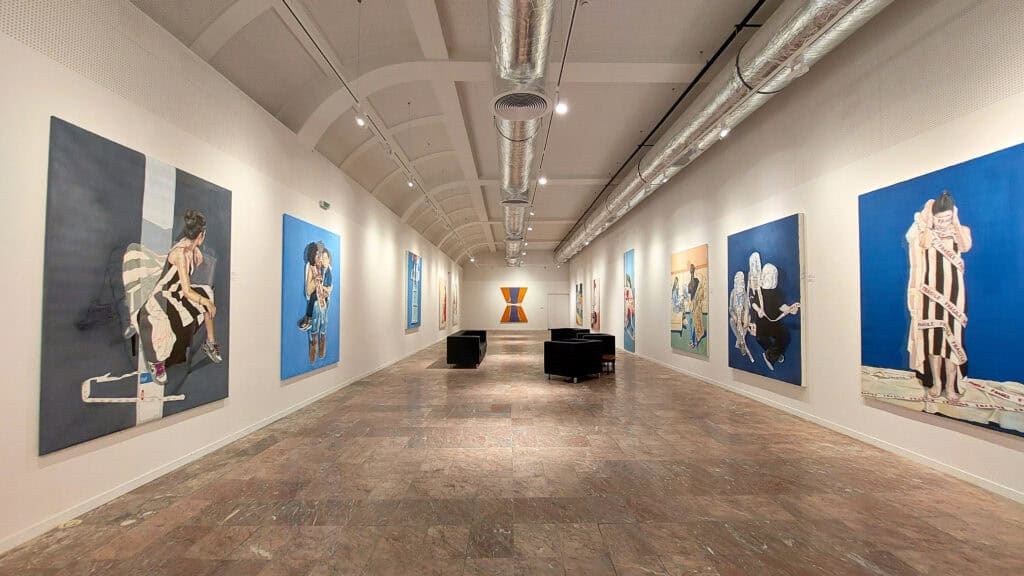
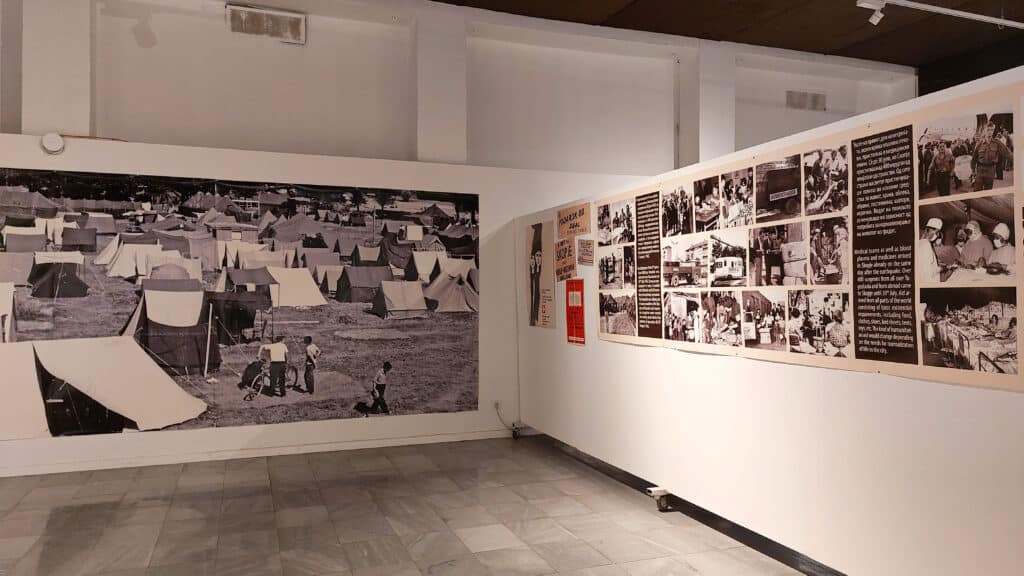
Debar Maalo District and Its Cafes
Debar Maalo, area is the university district and there’s an abundance of cafe’s and night life. We visited Kantina, which had a modern, European menu with craft ale, cocktails, juices plus swing seats (not compulsory!).

Skopje City Park, Stadium, Zoo and Dino Park
City Park is a popular part of Skopje, being the largest park in North Macedonia and the lungs of the city. it includes a main park area, the national football stadium and zoo.

There’s shops, restaurants and bars, plus outside events taking place throughout the year. We heard roaring and went to investigate. A plastic giraffe marked the entrance to Skopje zoo. It was a little dilapidated and we didn’t linger long but found the source of the roaring – a dino park! The ticket lady was pressing buttons to make the dinosaurs roar as we went past them.!


Food and Drink in Skopje
Of course, no city break is complete without food and drink and Skopje has plenty worth sampling. We ate very well in Skopje. While pizza, pasta and burgers are ubiquitous, we especially enjoyed the traditional Macedonian dishes and local wine. Check out some popular dishes listed here.
- Tavce gravce – tomato bean dish, flavoured with paprika. Baked beans, basically, but so much better!
- Pastrmalija – a freshly baked flatbread can be topped with meat or egg and served with peppers
- Fish soup – North Macedonia is land locked, but has lakes, the largest is Lake Ohrid. Expect the soup to have fresh water fish in it.
- Makalo – a tangy dip to go with bread or anything else!
- Selsko meso – slow cooked stew containing pork, white wine and mushrooms
- Baklava – tasty pastry desert made with honey and nuts
Our highlight was Kuka. Traditional Macedonian cooking served in an even more traditional setting, We nearly didn’t go as it was down several back streets and not easy to find and then looked closed, but it wasn’t!
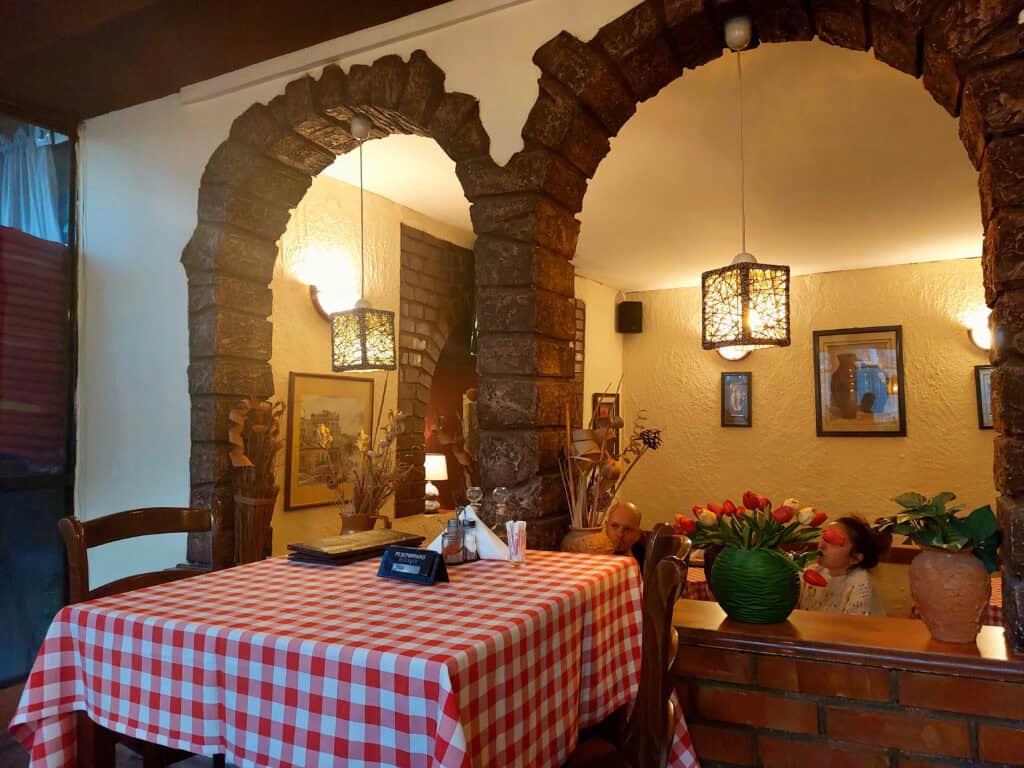

Here we had a proper Macedonian feast – tavče gravče (the national baked bean dish, served bubbling in a clay pot with cheese on top) plus a schnitzel piled with fries and salad, with fresh bread on the side. Hearty, simple, and exactly the kind of meal you’ll find across Skopje’s traditional restaurants. Also washed down with a carafe of excellent local Macedonian wine.
I also recommend Kolektiv in Macedonia Square and Old Town Brewery in the heart of the old Bazaar area where I particularly recommend the bar snacks menu, including the freshly baked bread.



Once you’ve had your fill, Skopje also makes a great base for exploring further afield.
Whether you’re just passing through or staying a few days, here are some simple ways to structure your time. Each links directly to the main sections of this guide so you can dive deeper.
Day Trip to Skopje
Here’s how you could structure your day to make the most of it, if you only have one day in Skopje
- Morning – Explore the Old Bazaar & Ottoman Skopje
- Afternoon – Cross the Stone Bridge and take in the bold architecture of Skopje 2014 Makeover and Vardar Riverfront
Two Days Or More In Skopje
If you have more than one day, here are some suggestions as to how you spend your time.
- Day 1 – Follow Day 1 Itinerary
- Day 2 – Take the bus and ride the cable car up to Mount Vodno & millennium Cross, then visit the Cathedral of St Clement of Ohrid and Memorial House of Mother Teresa and finish in Debar Maalo’s cafes.
- Day 3+ – Add a day or half day trip to (Matka Canyon, Tetovo, or even across the border into Kosovo) or spend more time in the city’s museums, parks and concert halls.
Recommended Trips from Skopje
These are the side trips we took while we were in Skopje. We travelled to each independently.
Trip to Mount Vodno & Millennium Cross
Mount Vodno provides the backdrop to Skopje. The Millennium Cross on top is huge. It’s 66 metres high or about the height of a 20 floor skyscraper and a ‘must visit’ if you’re in Skopje. We visited the mountain and the cross independently on a city bus, instead of taking a tour.

Here’s we can see the millennium cross ad the cable car and station. Check out my trip report, for details of the building in the middle!
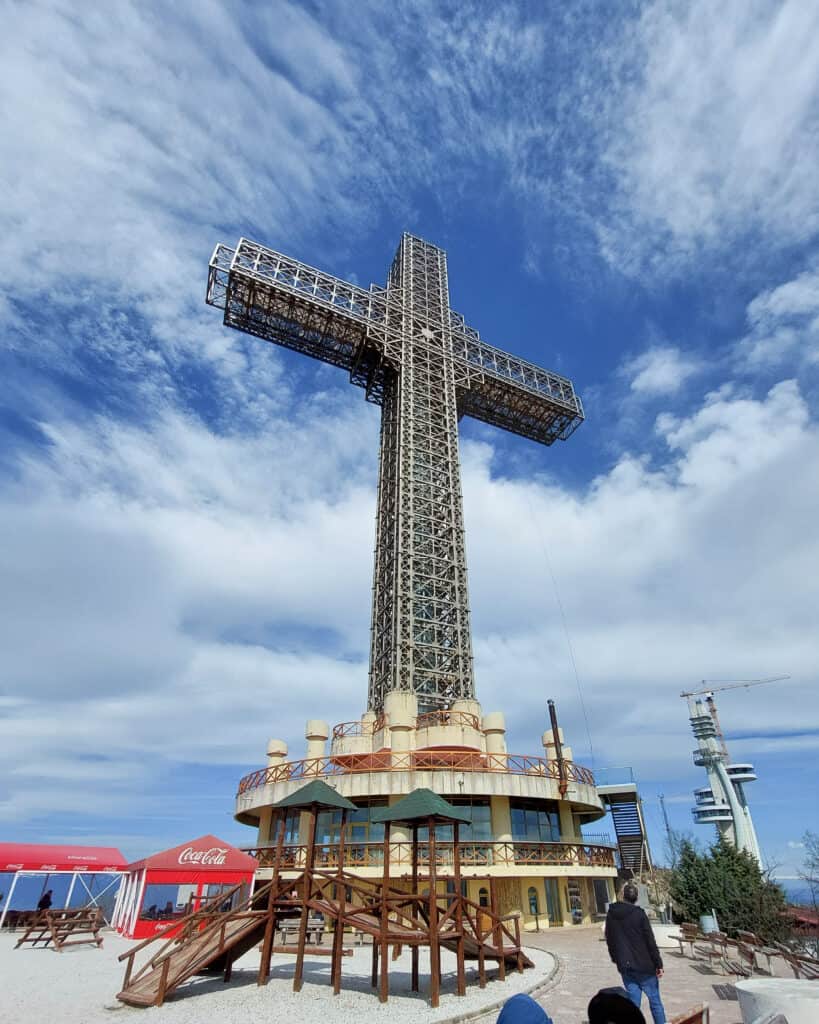
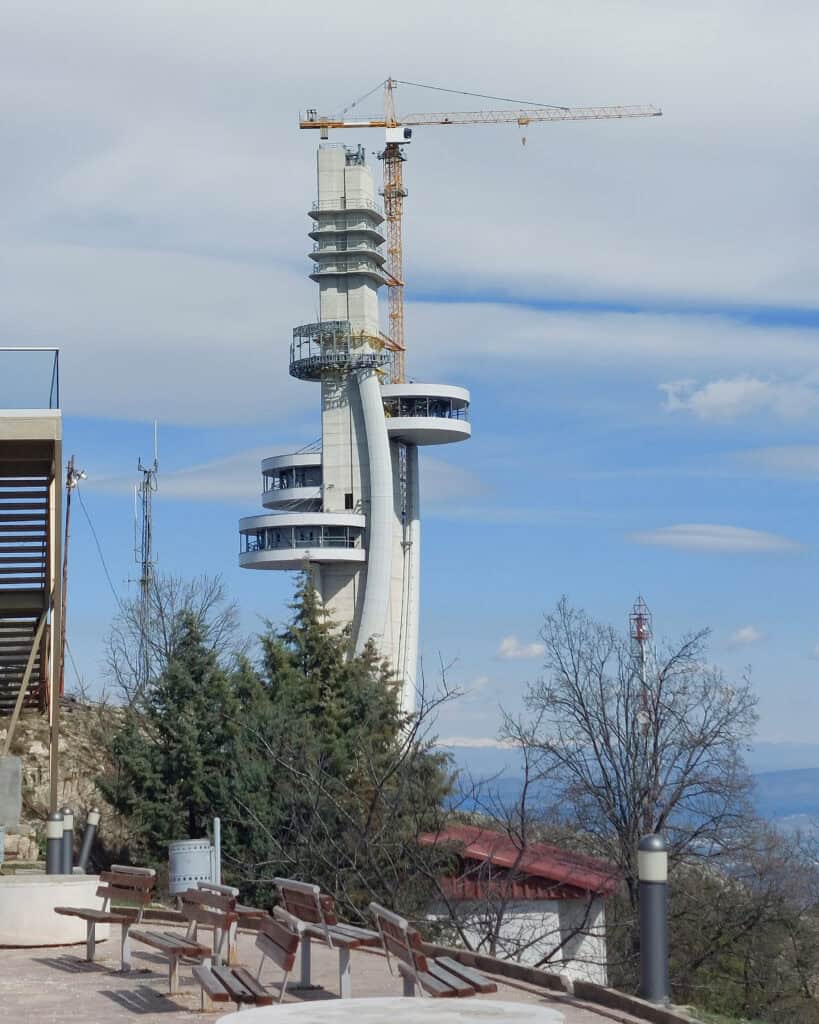

There’s quite a view at the top!

Trip to Matka Canyon
Matka Canyon is also a top trip from Skopje, it’s close to Mount Vodno, and like Mount Vodno, you can visit on the public bus or take a tour.
Here are some highly rated tours from Skopje to Mount Vodno and the Millennium Cross and Matka Canyon.
Trip to Tetovo and the Painted Mosque
An easy day trip on the public bus (coach) to Tetovo which is about 50 minutes away from Skopje. The painted mosque is one of the most spectacular mosques in the Balkans, if not Europe. The mountain backdrop and charming riverside, setting are ‘picture perfect’. Find out about this day trip to Tetovo, which we made from Skopje.


Other Destinations in North Macedonia
Lake Ohrid and Bitola would be excellent choices for trips beyond Skopje and I plan to visit both places in the near future.
Visiting Kosovo
We visited both Pristina and Prizren, both in Kosovo on the local public buses. We took the opportunity to stay over. I highly recommend visiting if you can.
Here are some highly rated tours from Skopje if you don’t want to travel independently or you would prefer a day trip.
Visiting Skopje – Your Questions Answered
Travel to Skopje
There are flights from other European cities to Skopje (SKP) including carriers such as WizzAir, Pegasus Air and Croatia Air. Here are transport options to/from the airport to the centre:
- Shuttle Bus – The easiest way to reach Skopje International Airport from the city centre is the airport shuttle bus, run by WTransporter/Erak Transporter. It leaves from the central bus station and a few central stops, costs about 199 MKD (€3.30) one way, and takes around 35–40 minutes depending on traffic. Timetables are linked to flight schedules, with services running roughly 08:00–20:00, and you can buy tickets from the driver or counter (cash in MKD is easiest).
- Airport Taxi – Official airport taxis in white, numbered (1–65), operate 24/7 from the airport. The fare from the airport to the city centre is €25 (MKD 1,500). The fare is fixed, so even nights or weekends are the same price. The fixed rate is posted at the taxi rank / inside the taxi. There’s no Uber or Bolt.
There are currently no International train services – services are currently suspended. There’s a network of buses/coaches connecting Skopje with the rest of Europe including services by Flixbus. We took a minibus over the border into Kosovo. Not all services are recorded or bookable online. Check details at the Central bus station.
- For City Buses – Check Visit Mount Vodno or Matka canyon by Public bus for tips and advice.
- For buses travelling beyond skopje – Check Visit Tetovo by public bus for tips and advice.
Other Travel Practicalities
Need the basics? Here’s a quick Q&A with everything you’ll want to know about visiting Skopje — from visas and currency to plugs, phones and safety.
If you like Skopje, and North Macedonia, here are some other popular posts on One Small Bag blog. I’m just writing up trips from Skopje, over the border into Kosovo. If you’re interested do please subscribe and I can update you
-
Best Things to Do in Iași: Discover Romania’s Cultural Gem
In this guide you’ll find a map and a walking route through Iași’s historic centre, plus a few finds further out. Itineraries, food and drink recommendations, and practical tips for your visit are included here too.
-
Visit the Painted Mosque in Tetovo From Skopje by Public Bus
In the foothills of the Šar Mountains, Tetovo’s Painted Mosque dazzles with colour — and it’s an easy bus ride from Skopje, making it one of the most rewarding day trips in North Macedonia
-
Everything You Need to Know Before Visiting Liechtenstein
Are you thinking about visiting Liechtenstein? Or maybe you need to know more before deciding? Here’s everything you need to…
Blimey,this is a VERY comprehensive blog ! I shall have to leave it until tomorrow -I have a beef bourgignon & a bottle of red to attend to
Brilliant Christine. I hope to be there next month so this is super helpful.
Oh that’s wonderful. Have an amazing time! If you have time, it’s about on hour on the bus to Tetovo which is well worth a visit. Alternatively you can pop over the border on a bus to Pristina and Prizren in Kosovo. The blog posts for those aren’t ready yet, but get in touch if you want to share notes!
Late reply. Hope it was helpful and you enjoyed your trip!
Be very afraid Retired Martin! 🙂
It did! *Joking* 😂